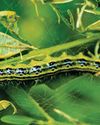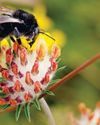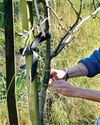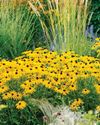
Either this plant has lost its scent or I have lost my sense of smell; but the musk mallow, even without a scent, is a worthwhile garden plant. This mallow can be found growing in meadows at the end of summer, but in a garden it becomes taller and much more flowery – the flowers are a lovely silvery-pink, and the height may reach 4ft (1.2m).
The mallow family is a great favourite of mine, but unfortunately, many succumb to the horrible hollyhock rust, and one of the reasons I prize Malva moschata is that the plant resists this fungus disease, which caused me to give up trying to grow hollyhocks.
Many writers on gardening recommend the white form of this plant, but this is probably because it seems more unlike the plant they see growing in the meadows. It is true that if this mallow grew in quantity in fields about my garden I should not import it, but it does not and so I give its clean, pale flowers a warm welcome every August. Grow it from seed; it is cheaper and from the disease point of view, it is safer.
The stinking hellebore
The ‘stinking hellebore’ (Helleborus foetidus) is the finer of the two species of Helleborus that are rare English wildflowers. The other species, Helleborus viridis, though good, has not the striking quantity of blooms and they are not carried with the ineffable grace of H. foetidus. Do not be put off by the name ‘stinking hellebore’; it is not really an unpleasant scent, nor is it to be noticed at all except by one who sniffs it at close quarters.
この記事は Amateur Gardening の February 19, 2022 版に掲載されています。
7 日間の Magzter GOLD 無料トライアルを開始して、何千もの厳選されたプレミアム ストーリー、8,500 以上の雑誌や新聞にアクセスしてください。
すでに購読者です ? サインイン
この記事は Amateur Gardening の February 19, 2022 版に掲載されています。
7 日間の Magzter GOLD 無料トライアルを開始して、何千もの厳選されたプレミアム ストーリー、8,500 以上の雑誌や新聞にアクセスしてください。
すでに購読者です? サインイン

To dig or not to dig?
Should we be carrying out a full dig on plots now? Bob considers the pros and cons of the 'autumn dig' debate

The box ball blues
As if his beleaguered box hadn't already taken a beating, Toby now has to deal with some hungry box caterpillars

Save your own seeds
Masterclass on: seed saving

Strange sightings
Three unusual insects turn up in Val's garden in one day

A bolt from the blue!
Cornflowers are perfect for garden and vase

Winter moth prevention
Ruth shows you how to avoid maggoty tree fruits

Create a winter container
There are as many options as in summer

Lightweight gardening tools
AS well as being good for our mental health, gardening is also great exercise.

Autumn price round-up
AG finds better bargains in lesser-known brands

Rudbeckias
Rudbeckias are ideal for sunny summer patios and borders, with some able to survive our coldest winters